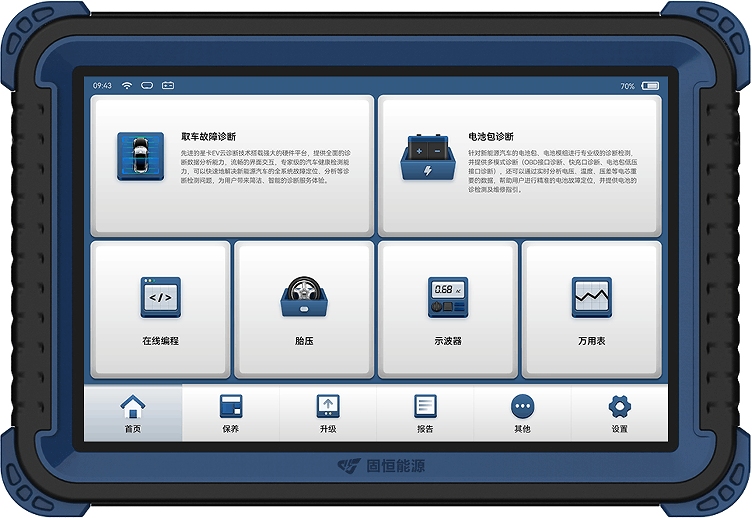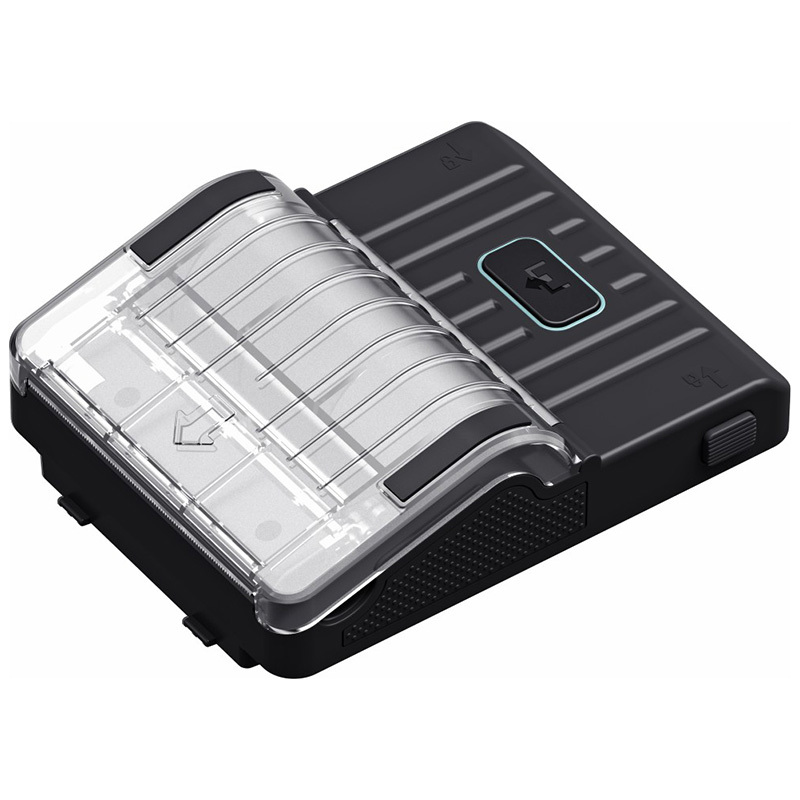
With the rapid global adoption of new energy vehicles, the complexity of their core technologies—batteries, motors, and electronic control systems (the three-electric)—has posed unprecedented challenges to the traditional auto repair industry. Against this backdrop, professional new energy vehicle diagnostic instruments have taken center stage in maintenance. They are no longer just optional tools, but the cornerstone for safe, efficient, and accurate maintenance. This article will delve into the three core functions of professional new energy vehicle diagnostic instruments launched by Guheng Energy: in-depth diagnostic capabilities, precise battery SOC testing, and comprehensive vehicle diagnostics, revealing how data will drive the future of new energy vehicle maintenance.
The Key to Maintenance Lies in “Accurate Diagnosis”
The “heart” of traditional fuel vehicles is the engine, and its maintenance system has been highly mature after a century of development. The “heart” of new energy vehicles, on the other hand, is a highly integrated the three-electric system. Its operating status is monitored by numerous sensors and control units (ECUs), transforming any issues into data streams. A minor voltage anomaly or a sporadic fault code could indicate a potentially serious failure or safety hazard. Therefore, maintenance in the new energy era is no longer about “tear it down and check,” but “connect it and read it.” Repairs based on guesswork and experience are not only inefficient but can also lead to secondary failures or even accidents. Professional new energy vehicle diagnostic instruments, such as the series independently developed by Guheng Energy, act as both “professional translators” and “physicians.” They communicate deeply with the vehicle’s control system, transforming obscure binary code into intuitive visual information, allowing repair technicians to peer inside the vehicle and achieve the transition from “experience-based repair” to “data-based repair.” Next, we’ll focus on three core functions to see how Guheng Energy empowers modern maintenance.
Core Function 1: Deep Diagnosis
When a fault light illuminates on a new energy vehicle’s dashboard, there could be hundreds of possible causes. The deep diagnostic function of Guheng Energy’s new energy vehicle diagnostic instruments is the first key to unlocking these mysteries.

Multi-System Fault Code Identification
Unlike traditional OBD systems that only read engine fault codes, the Guheng Energy diagnostic instrument directly accesses the core control units of new energy vehicles. Whether it’s a battery management system (BMS) warning about cell voltage imbalance, a motor controller (MCU) warning about overtemperature or overcurrent, or an on-board charger (OBC) communication failure, these can all be accurately captured and interpreted as clear Chinese prompts. This not only helps technicians quickly pinpoint the fault location but also distinguishes between current and historical faults, greatly improving initial inspection efficiency.
Real-Time Data Stream Analysis
Fault codes are like a “medical history,” while real-time data streams are like a vehicle’s “real-time electrocardiogram.” The Guheng Energy diagnostic instrument allows technicians to view dynamic changes in hundreds of key parameters, such as:
- Drive motor: real-time speed, torque, temperature, and bus current.
- Battery pack: total voltage, total current, single cell voltage, and module temperature.
- High-voltage system: insulation resistance and high-voltage interlock status.
By observing changes in this data under different operating conditions, such as vehicle startup, driving, and charging, technicians can determine whether sensors are distorted and whether actuators are operating as instructed, thereby identifying “soft” faults that haven’t triggered a fault code.
Historical Data and Freeze Frame
The most challenging vehicle faults are often sporadic—”unresolved”—and “unresolved” during visits. The Guheng Energy Diagnostic Instrument’s freeze frame function perfectly addresses this pain point. When a specific fault code is triggered, the system automatically records all key data from the period before and after the fault, creating a “data snapshot.” Technicians can analyze the vehicle’s condition at the moment of the fault, much like reviewing surveillance footage, providing irreplaceable insight for reconstructing and diagnosing intermittent faults. The Guheng Energy Diagnostic Instrument also features a printer module for instant printing of test results.

Core Function 2: Accurate Battery SOC Testing
The battery is the core value of new energy vehicles, and its health directly determines the vehicle’s range and value retention. The Guheng Energy Diagnostic Instrument’s battery testing capabilities far exceed the simple display on the vehicle’s built-in instrument panel.
Why is SOC so important?
SOC (State of Charge) is the state of charge, or simply the amount of battery remaining. Its accuracy is crucial. An inaccurate SOC can lead to:
- User anxiety: The displayed range suddenly drops, making the user lose confidence in the range.
- Vehicle risk: The vehicle may suddenly break down due to actual battery depletion.
- Battery damage: This can cause the battery to overcharge or over-discharge, accelerating the degradation of its lifespan.
Beyond the displayed SOC value
The SOC value displayed on the vehicle dashboard is often “beautified” and estimated by the manufacturer’s strategy. The Guheng Energy Diagnostic Instrument communicates directly with the BMS and utilizes a high-precision Coulomb integration method and voltage-temperature compensation model to read and calculate a battery’s remaining charge value that is closer to the actual value. For repair shops, this means they can more accurately determine the true battery condition of a used new energy vehicle. For car owners, technicians can verify the accuracy of the SOC display with the Guheng Energy Diagnostic Instrument, eliminating any concerns.
Battery State of Health (SOH) Assessment
If SOC represents “how much fuel is left,” then SOH (State of Health) represents “how full the tank is.” SOH reflects the degree of capacity decay and performance degradation of a battery pack relative to its new state. The Guheng Energy diagnostic instrument comprehensively assesses the battery’s health percentage by analyzing data such as the battery’s full charge capacity, internal resistance change, and cycle count. This assessment report is highly valuable as a core basis for used vehicle transactions, battery warranty claims, and determining the need for battery balancing maintenance.
Core Function 3: Comprehensive Vehicle Diagnosis
New energy vehicles are highly coordinated systems. In addition to the three-electric system, the vehicle control unit (VCU) acts as a “commander-in-chief,” coordinating the operations of various subsystems. The power of the Guheng Energy diagnostic instrument lies in its comprehensive vehicle diagnostic perspective.
VCU (Vehicle Control Unit) Diagnosis
The VCU is the vehicle’s highest decision-making unit, responsible for receiving signals such as the accelerator and brake pedal and issuing commands to the BMS, MCU, and other systems. The Guheng Energy diagnostic instrument can access the VCU and read its software version, configuration information, fault codes, and data flow. For example, when a vehicle experiences acceleration failure, by comparing the torque command issued by the VCU with the actual torque executed by the MCU, it’s possible to quickly determine whether the problem lies with the control or execution side.
High-Voltage System Safety Testing
Safety is the paramount concern for high-voltage vehicle maintenance. The Guheng Energy diagnostic instrument integrates professional high-voltage safety testing functions. These functions are not only a maintenance procedure but also essential for ensuring the personal safety of technicians.
- Insulation Resistance Test: Automatically checks the insulationperformance of the high-voltage line to the vehicle chassis. Any insulation failure poses a risk of leakage and requires immediate repair.
- High-Voltage Interlock (HVIL) Test: Detects the continuity of the entire high-voltage connection circuit. Any loose or disconnected connectors are immediately identified, ensuring that high voltage electricity flows only within a completely sealed circuit.
Thermal Management System and Auxiliary System Inspection
Battery thermal management and the passenger compartment air conditioning system directly impact vehicle performance and safety. The Guheng Energy diagnostic instrument can perform operational testing and diagnosis on these auxiliary systems. For example, it can proactively activate the battery cooling water pump, PTC heater, or air conditioning compressor to monitor their proper functioning and read sensor feedback to ensure the vehicle maintains optimal operating conditions even in extreme temperatures.
Choose Guheng Energy for professional maintenance and repair
To do one’s job well, one must first sharpen their tools. Amid the booming development of new energy vehicles, the repair industry is facing a profound reshuffle and upgrade. Repair shops that are the first to equip advanced tools like Guheng Energy’s professional diagnostic instruments will establish a strong technical barrier through their capabilities for in-depth diagnostics, precise battery testing, and systematic vehicle analysis.
FAQ
Q: Is a dedicated diagnostic instrument required for new energy vehicles? Can traditional OBD computers be used?
A: A dedicated diagnostic instrument is required. Traditional OBD computers primarily detect engine failures and cannot access core control units such as the battery and motor in new energy vehicles. Guheng Energy’s professional testing instruments, with their built-in proprietary protocols, enable in-depth diagnostics and data analysis, making them a prerequisite for safe and effective maintenance and repair.
Q: If the battery SOC reading is inaccurate, can this diagnostic instrument be used for calibration?
A: Yes. The Guheng Energy diagnostic tool features a SOC learning value reset or calibration function, which helps the vehicle’s BMS relearn and calibrate the battery level display. This resolves inaccurate SOC display caused by prolonged shallow charging and discharging, restoring accurate range estimation.
Q: Is the Guheng Energy diagnostic tool complex to use? Does it require specialized knowledge?
A: The Guheng Energy diagnostic tool is designed with user-friendly features, offering a clear Chinese interface and guided process. Basic operations like reading fault codes are easy to learn. However, functions like in-depth data stream analysis and encoding require a background in new energy vehicle technology. We recommend that you use a professional repair technician.
Q: Will the diagnostic tool’s functions become outdated? How can I update it?
A: The Guheng Energy diagnostic tool supports online upgrades. We continuously provide software updates to cover new models, systems, and features, ensuring that our tool remains adaptable to evolving technologies and protecting your investment.




